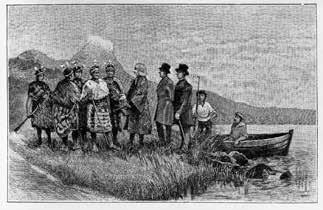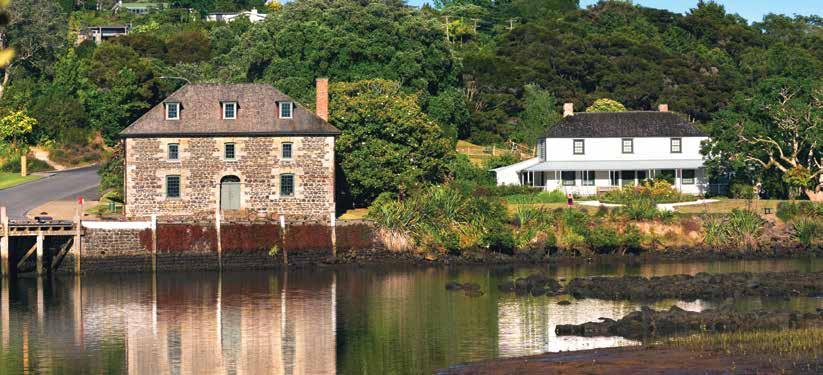
5 minute read
17 NORTHLAND

Matter of faith for intrepid explorers
Gruelling journeys bushwhacking through near-impenetrable forests while living off meagre rations of berries and fern roots may not be everybody’s idea of living their best life.
Yet for many missionaries, who were some of the first Pākehā to settle in Aotearoa New Zealand, marching off the map was all part of a very wide-ranging job description.
Besides preaching Rongo Pai – the Good News – to Māori, part of their mission was to seek out new territory with a view to expanding their presence around the country. “This group of people were not averse to a bit of hardship,” says Heritage New Zealand Pouhere Taonga Northland Manager, Bill Edwards.
“Inspired by their deep convictions, the missionaries were willing to upend normal lives in England to spend six months travelling on a sailing ship to the other side of the world, and endure frontier conditions in a cultural landscape that would have been completely alien to them. A bit of privation was all part of the package.”
Once Christian missions had been established in Northland at Rangihoua, Kerikeri, Te Waimate, Māngungu and Kororāreka Russell, it was only a matter of time before missionaries turned their attention to pastures new.
“In fact, missionaries to New Zealand had long recognised the potential of the country before the Northland missions were even established,” says Bill.
The Rev Samuel Marsden set a cracking pace for exploration. Days after preaching his famous Christmas Day sermon at Rangihoua in 1814, Marsden accepted Hongi Hika’s invitation to visit his inland pā. Travelling by waka – and then walking overland – the party reached Okuratope Pā at Waimate North, making Marsden the first European to travel that far inland.
Impressed, Marsden recorded seeing majestic kauri forests and – among other things – excellent spuds: “I have never seen finer potatoes under the best culture,” he waxed.
During the trek, Marsden also visited Kororipo – the site where the Kerikeri Mission House and Stone Store would be built – pre-Treaty buildings that have survived for almost two centuries.
“New South Wales Governor, Lachlan Macquarie, had instructed Marsden to explore as much of the coast and the interior of New Zealand as time would permit, so Marsden eagerly accepted Hongi’s invitation,” says Bill.
“After seeing the potential of the land at Waimate North, Marsden then spent the next six weeks travelling south on the Active as far
as the Firth of Thames, stopping in at different harbours on the way, meeting with rangatira, talking about the mission to New Zealand – and generally assessing the land for its resources and potential for settlement.”
Marsden had a desire to explore the country and meet its people, and his journals record in vivid detail his long journeys to isolated places reached only through traversing rugged bush country – often places where no European had previously ventured. On his third visit to New Zealand in 1820, for example, he got as far as Tauranga then headed back north via the Kaipara.
Displaying similar fortitude, missionaries James Hamlin and Rev Alfred Nesbit Brown left the relative comfort of Te Waimate Mission – cared for by Heritage New Zealand Pouhere Taonga today and recognised as a Tohu Whenua – to explore the Waikato via the Kaipara and the Waitematā. Setting off on 26 February 1834, and accompanied by a party of 19 Māori guides and porters, their arduous journey was to take nearly five months.
Brown, Hamlin and their team of explorers beat their way through miles of trackless country, rough paths and pig tracks, dense fern and muddy river-beds – finally catching their first glimpse of the Waikato River on 19 March. It had been three weeks since they'd left home.
“It made good sense for the expedition to explore the Waikato River by boat – though waka were few and far between,” says Bill. “They solved the problem by forming a temporary ‘dockyard’ of sorts and building 10 moki – rafts – bundled together from rushes.”
Hamlin recorded in his journal that “no two [moki] were alike either in shape or size. About 10 o’clock had our mokis finished and everything ready for starting. Launched our mokis which were no less diversified in their sailing than they were in their shapes and sizes.”

The flotilla of wildly eclectic-looking rafts was eventually met by a waka paddling upstream towards the Waipa River. A brother of Te Wherowhero was in the waka, along with a European traveller, who directed the expedition back up to Ngāruawāhia. It was here – the centre of trade routes from the Waikato River and the Manukau Harbour – that Captain John Kent had established a flax trading enterprise.
“Following conversations with Kent, Brown, Hamlin and their Māori support crew continued exploring, eventually reaching a spot where they were able to see Mt Tongariro in the distance. They also reached Kāwhia and Raglan on the west coast,” says Bill.
The efforts of the early missionaries paid off. By the end of 1835 missions had been established at Mangapouri, Matamata, Tauranga and Rotorua, as well as the early missions at Kerikeri, Te Waimate and Rangihoua. And those were just the Anglican ones. The Wesleyans and Catholics were also active in establishing missions around the country.
As well as being some of the earliest Pākehā settlements in New Zealand, two of the earliest missions – the Kerikeri Mission Station and Te Waimate Mission – also bear testimony to an unusual group of people who were willing to march off the map.
Today both historic places are cared for by Heritage New Zealand Pouhere Taonga and are recognised as Tohu Whenua. They are also open to the public. We invite you to do some exploring yourself of these stories and others at our properties around the country.
Visit www.heritage.org.nz and www.tohuwhenua.nz for more details.
Writer: John O’Hare
1. The Kerikeri Mission precinct. (CREDIT: GRANT
SHEEHAN/HERITAGE NEW ZEALAND POUHERE TAONGA)
2. The landing of the Rev Samuel Marsden at the Bay of Islands, 19 December 1814. Engraving,
1913. Artist unknown. (CREDIT: REFERENCE NUMBER:
PUBL-0158-76 ALEXANDER TURNBULL LIBRARY)
3. The Stone Store and Kemp House. (CREDIT: GRANT







